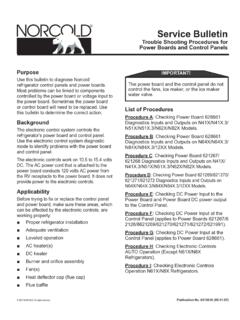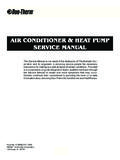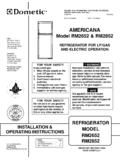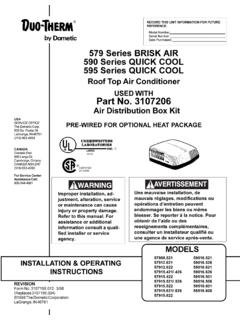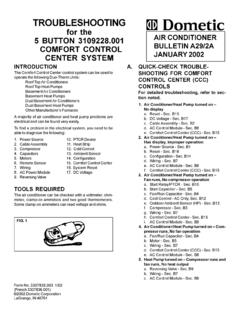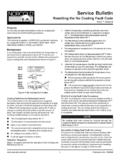Transcription of Ice Maker Bulletin Layout - Bryant R.V
1 Service Bulletin service Bulletin provides troubleshooting and servicetips for the ice Maker water solenoid valve and the norcold gas/electric refrigerators with factory installedice failure of the ice Maker to eject ice cubes may berelated to improper winterization or not winterizing thewater solenoid valve. The customer reports that the icemaker: Is not making ice or will not eject the ice from the mold. Cycled a few times, then stopped ejecting the ice fromthe indications may include: Icicles and ice formation on the sides of the ice makerand ice buildup on the surface of the freezer plate. Water overflowing the mold when the water solenoid valveis not valve s water chamber (see Figure 1) always retainswater. Leaving the garden hose fitting attached to the valvewill allow more water to be retained in the valve. In ambi-ent freezing temperatures, water retained within the valvewill freeze.
2 As the water freezes, it will tend to move theorifice, washer seal, and strainer out of strainer, which is normally recessed about 1/8 inchinto the inlet (see Figure 1), provides the best clue foridentifying a valve that has been subjected to freezingtemperatures. The visual clue is a deformed strainer cup.(see Figure 2). The cup end of the strainer will be flushwith the inlet fitting opening. In this position, when the icemaker cycles and energizes the water solenoid valve, themold fill capacity will be exceeded. The normal mold watercapacity is fl. oz. (140 mL). The ice buildup in thevalve s water chamber may also deform and unseat thewasher seal. This will cause water to bypass the valve sseat and flow continuously into the the excess water in the mold freezes over the formedice cubes, it fuses the ice cubes into a single block of 093002 Service BulletinIce Maker ServiceFigure 2.
3 Components location after SeatDiffuser PlateWater ChamberBracketSolenoid120 VacMale Quick-ConnectorsOrifice DiskWasher Seal1/8 InchStrainer crinkled endflush with inlet plate, orifice,and orifice seat may beout retained inthe valve's waterchamber 1. Ice Maker water solenoid the ice ejection cycle, the ejector blades cannotovercome the surface tension created by the layer of icethat is fusing the ice cubes into a single block of ice. Thiscauses the ice Maker motor oscillate continuously as ittries to overcome the surface tension imposed by the Bulletin 09-30-02 How to Check the Position of the StrainerIf the valve froze, most likely the strainer, orifice plate,orifice, and orifice seat will be out of place. This will causeexcessive water in the mold and the ice Maker will fail toeject the ice cubes. The position of the cup end of thestrainer is the best visual indication to determine if thevalve have been tampered with or exposed to ambientfreezing normal position of the strainer is shown in Figure 1.
4 Ifthe components have been tampered with or the valve wasexposed to ambient freezing temperatures most likely thestrainer is in the position shown in Figure 2. To check theposition of the strainer:1. Shut off the water supply to the ice Disconnect the garden hose fitting to expose the cuppedend of the strainer. If the strainer end is seated approximately 1/8 inch inthe inlet opening of the valve, the orifice seat, orifice,diffuser plate and strainer are in their correct to the Operational (cycle) Test, see page 3. If the strainer end is crinkled and flush with the edge ofinlet opening, most likely the strainer, diffuser plate,orifice, and the orifice seat are out of to Reposition the Orifice Seat, Orifice,Diffuser Plate and StrainerTo reposition the orifice seat, orifice, diffuser plate, andstrainer in the inlet opening:1. Carefully pull out the strainer with a small flat tipscrewdriver.
5 Use caution as not to pierce, crush, ordamage the Pull out the diffuser plate, orifice, and orifice Position the orifice seat, orifice, diffuser plate, and straineras shown in Figure 3. When reassembling thesecomponents, always make sure: The orifice seat is fully seated in place. The orifice is fully seated in the orifice seat. The back side of the diffuser plate is fully seated againstthe orifice. The strainer is fully seated and there is approximately 1/8inch gap between the end of the strainer and the inletfitting Connect the garden hose fitting to the Reconnect the water supply line to the garden Cycle the ice Maker . See Operational (cycle) Test, SeatDiffuser PlateFigure 3. Arrangement of inlet side ProcedureTo winterize the ice Maker :1. Shut off the RV water supply to the ice Raise the ice Maker shut-off arm until it locks in the Disconnect the garden hose water inlet connection fromthe water solenoid Disconnect the ice Maker water supply line from thewater solenoid valve.
6 Do not unwrap the water lineheater wire from the water solenoid valve Allow the water to drain from the supply line and the icemaker water Protect connections by bagging and taping all line andwater solenoid valve connections with clean plastic bagsand to Check for a Damaged Washer SealIf the water seal is damaged, water will drip continuouslyout of the valve s outlet fitting. To check the water solenoidvalve for constant leakage:1. Disconnect ice Maker water supply line from the watersolenoid valve outlet Thoroughly dry the valve s outlet Turnon the RV water supply to the ice Observe the outlet fitting for water leakage (dripping).Replace water solenoid valve if the water solenoid valve Bulletin not perform this test if the ice ejector is trapped in theice cubes (mold was overfilled). Allow the ice to thawbefore performing the cycle perform an ice Maker cycle test:1.
7 Shut off the water supply to the ice Maker water Make sure the ice Maker is connected to the wireharness and that the circuit is energized (120 Vac).3. Make sure the ice Maker shut-off arm is in the down (ON) Measure voltage across test points L and N. 120 Vacshould be available to the ice !Shorting test points T and H will start the the jumper wire from test points T andH when a click sound is heard or immediatelyafter a period of 15 5. Test With an insulated jumper wire (14 AWG 1/2 inch of insulation from each end), short terminalsT and H. See Figure 5. The following events should takeplace during the cycle: The mold heater starts to heat the mold. The ice Maker ejector its cycle. About 15 seconds into the cycle, the heater thermostatshould produce a click sound . Remove the jumperwire at this time. Not removing the jumper wire willcause damage to the heater and/or overheat themold, which will ruin the ice Maker .
8 Halfway through the cycle, the water solenoid valve Time the length of time the water to determine the amountof time it remains energized (it should not exceed ).7. If the water solenoid valve does not remain energizedbetween and seconds: Allow the cycle to come to an 4. Mounting screws location. Adjust the fill time duration using the water filladjustment screw. Turn the screw clockwise to decreasethe fill time; turn counterclockwise to increase the filltime. Each 1/4 turn varies the fill by (10 mL). Thesmall hole in the water fill screw adjustment indicatorshould be centered in the module casing hole (see Figure5). Cycle test the ice Maker . Time the water solenoid valveagain to determine the amount of time it remainsenergized. The valve should remain energizedbetween to seconds. DONOTROTATEMANUALLYVLTHMNDISCONNECT POWERTO REMOVE MODULEUR185W-115V-60 HZIM # S 106 62664911 MAY 00WB1 Water FillAdjustment ScrewWater FillAdjustment ScrewAlignment IndicatorInsulated Jumper Wire(14 AWG with 1/2" long ends)Shut-off ArmCoverMounting ScrewsBottomMounting Screws(2 each)Freezer Plate Screws (2)(1 in.)
9 Long with washer)IMPORTANT!On 1200 LRIM refrigerators, the ice Maker mustbe removed to allow removal of module coverto access test points. See Figure 4 for mountingscrews location. Figure 5 shows test
